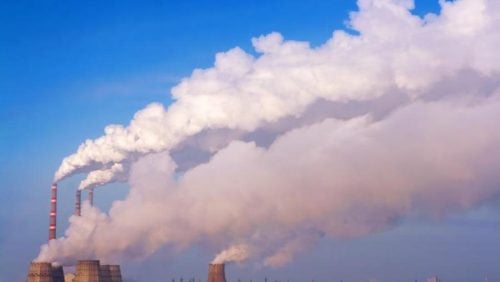Up in the Air: How the Atmospheric Trust Doctrine is Being Used to Fight Climate Change
January 29, 2024 by Mary Bush

Smokestacks emitting air pollution
As air pollution and global warming worsens across the United States, attorneys are looking to the Atmospheric Trust Doctrine to hold states accountable for their pollution.
As global warming becomes an increasingly pressing issue globally, activists, scholars, and attorneys alike have been looking to different theories and doctrines to hold their government and polluters accountable. Constitutional litigation, though not at the forefront of the climate activism movement, has gained momentum at the state and federal level—and even on the global stage—to hold governments accountable. Within a pocket of this litigation effort lies the atmospheric trust, an aggressive branch of the public trust doctrine that is best used to combat air pollution by big business.
Atmospheric trust litigation, a theory pioneered by Mary Christina Wood at the University of Oregon, “calls upon the judicial branches of government worldwide to force carbon reduction on the basis of their fiduciary responsibility to protect the public trust.”[1] Relying on the principles of the United Nations Framework Convention on Climate Change (UNFCCC) as a foundation for the theory, the atmospheric trust would provide a global means for swiftly addressing climate change without the promulgation of new rules or statutes.[2] The theory itself branches from the public trust doctrine—a doctrine that holds natural resources are held in a “trust” for the citizens of the world.[3] Within this public trust, the atmosphere is an asset, and as such, no sovereign nation is permitted to degrade it.[4] Any carbon pollution endorsed on behalf of these governments thus breaks their fiduciary duty to the trust and can result in litigation.[5]
While the public trust doctrine is a sound legal theory for its near global applicability, its stability in the United States federal government is a bit less clear. In 2012, the Supreme Court reiterated “the public trust doctrine remains a matter of state law;”[6] yet, in a federal court in Massachusetts, the court held that the public trust is “governmental and administered jointly by the state and federal governments.”[7] While the public trust doctrine is not definitively excluded from federal enforcement, the standard is vague at best. This has forced groups hoping to use the Atmospheric Trust Theory to primarily pursue claims only at the state level, where those specific jurisdictions have chosen to adopt a public trust doctrine.[8]
Even with limited applicability, groups like Our Children’s Trust have still managed to use this doctrine to produce tangible results through state constitutions. In the landmark case, Held v. State, 16 youth plaintiffs sued their government for violating their constitutional right to a safe and healthful environment.[9] Their state constitution specifically provides that “the state and each person shall maintain and improve a clean and healthful environment in Montana for present and future generations.”[10] Here, the state officials were the fiduciaries of Montana’s environment, and their degradation of Montana’s atmosphere and ecosystems proved to be a breach of their duty to the state and its citizens. Specifically, the plaintiffs claimed that the promotion of fossil fuel industry led to direct harms physical and environmental harms suffered by the plaintiffs directly in violation of their constitutional right.[11] Ultimately, the plaintiffs were successful, and were able to enjoin the state of Montana from ignoring the effects of fossil fuels on the states environment.[12]
While their litigation strategy was successful, it was not without flaws. Besides the obvious downsides of litigation as a tedious process, there is a limit to the number of states that have a public trust doctrine weaved into their state constitution.[13] Currently, those states are Hawai’i, Illinois, Massachusetts, Montana, New York, and Pennsylvania.[14] Though more states are considering adding a green amendment to their constitutions, the progress has been slow and tedious where oil and gas lobbying and climate skepticism deter stronger legislative measures.[15]
Nonetheless, the Atmospheric Trust Doctrine become a new tool for environmental litigators looking to slow climate change and hold governments responsible. Even with its flaws, its ability to make tangible changes in government shows its potential to create further positive change in the environmental space.
[1] Mary C. Wood, Atmospheric Trust Litigation Across the World, in Fiduciary Duty and the Atmospheric Trust 99, 102 (Ken Coghill et al. eds., 2012) https://law.uoregon.edu/sites/law2.uoregon.edu/files/mary-wood_0/mary-wood/ATL-Across-the-World.pdf.
[2] Id. at 102. The UNFCCC exists as a ratified treaty, signed by the United States amongst other countries, that supports and is consistent with an atmospheric land trust. Id.
[3] Id. at 106.
[4] Id. at 126.
[5] Id.
[6] The Public Domain: the Basis of the Public Trust Doctrine, The National Agriculture Law Center, https://nationalaglawcenter.org/the-public-domain-basics-of-the-public-trust-doctrine/; PPL Montana, LLC v. Montana, 565 U.S. 576 (2012).
[7] Id.; US v. 1.58 Acres of Land, 523 F.Supp. 120, 124 (D. Mass. 1981).
[8] Phil Gregory, Of Counsel, Our Children’s Trust, Address to Georgetown Environmental Law Society: Held v. State (November 9, 2023).
[9] Held v. United States, CDV-2020-307 at 23 (1st Dist. Ct. Mont., Aug. 14, 2023).
[10] Mont. Const. art. IX, §1.
[11] Held v. United States, CDV-2020-307 at 36 (1st Dist. Ct. Mont., Aug. 14, 2023).
[12] Id. at 23.
[13] Dernbach, John C., The Environmental Rights Provisions of U.S. State Constitutions: A Comparative Analysis (2023).
[14] Id. at 1.
[15] Jennifer Hijazi & Drew Hutchinson, Montana Ruling Boosts Case for States’ Green Amendments (2023).

